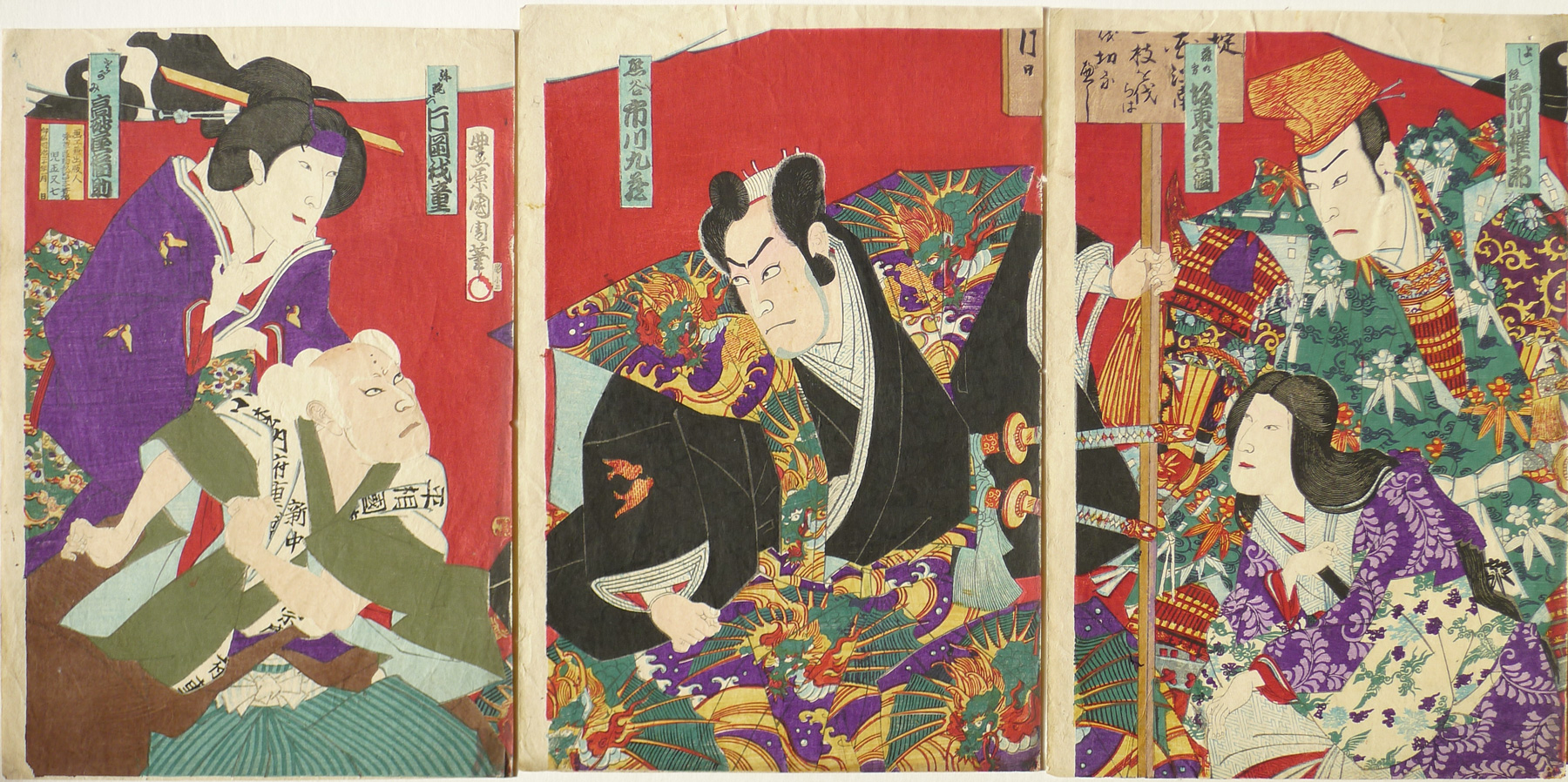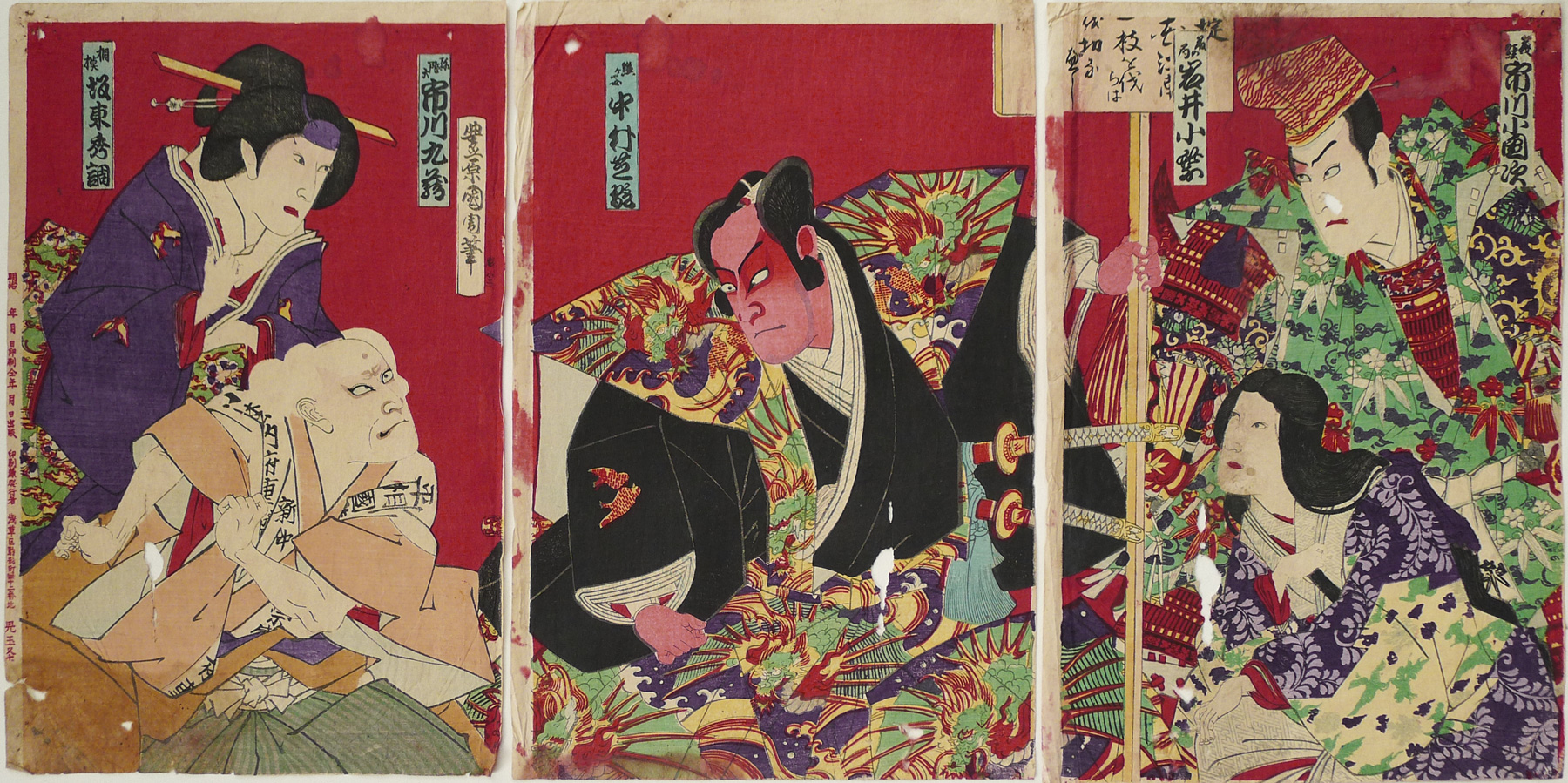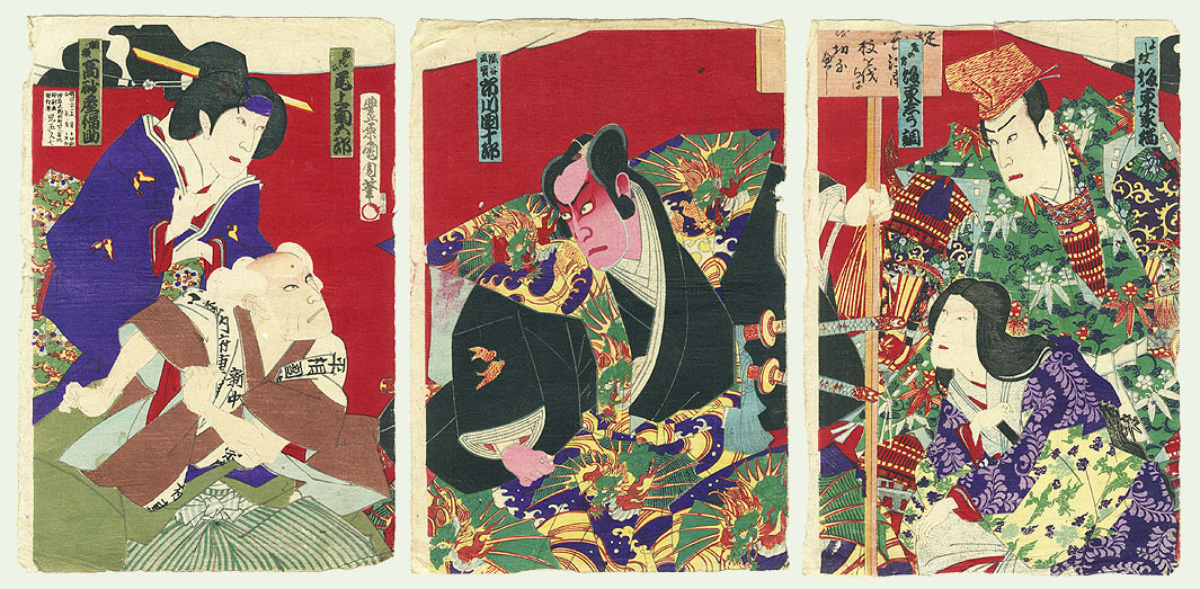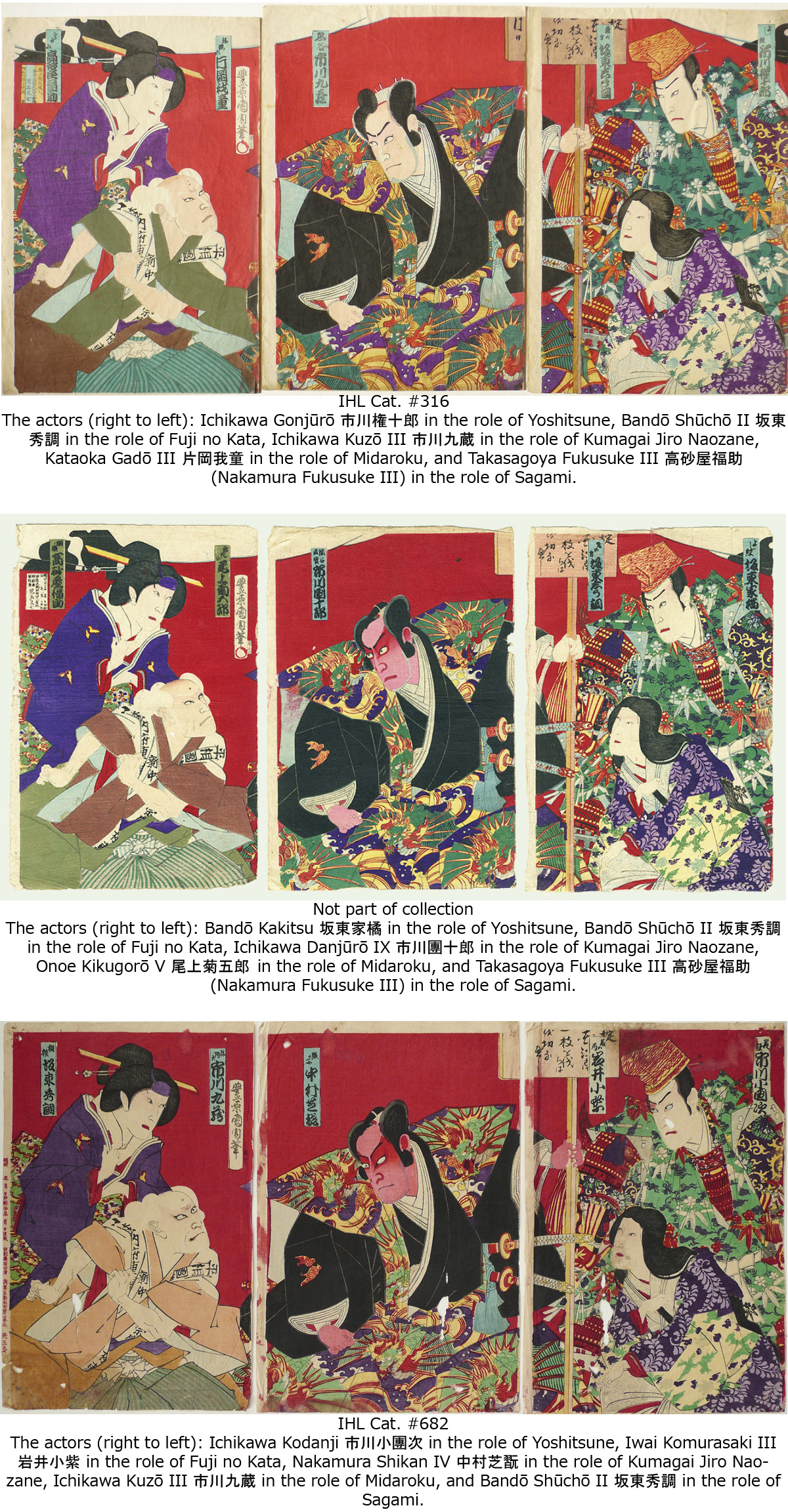About These Prints
Two prints by Kunichika picturing the "Kumagai Jin'ya" scene, the last scene in the play Ichinotani Futaba Gunki, a dramatization of the Heiki Monogatari tale of the battle of Ichinotani. Both of these prints were issued by the same publisher. The top print is dated January 1887, but the bottom print does not carry a date. The same blocks were used for the actors, but with a color change to the robe on the character Midaroku in the left panel and a different wig (katsura) and slightly altered face and addition of kumadori makeup used for the character Kumagai in the center panel. The actors, whose names appear in the cartouches, are different between the two prints with the exception of the actor Bandō Shūchō II who appears in the role of Fuji no Kata in the top print and the role of Sagami in the bottom print.The top print pictures the actors (right to left): Ichikawa Gonjūrō 市川権十郎 in the role of Yoshitsune, Bandō Shūchō II 坂東秀調 in the role of Fuji no Kata, Ichikawa Kuzō III 市川九蔵 in the role of Kumagai Jiro Naozane, Kataoka Gadō III 片岡我童 in the role of Midaroku, and Takasagoya Fukusuke III 高砂屋 福助 (Nakamura Fukusuke III) in the role of Sagami.
The bottom print pictures the actors (right to left): Ichikawa Kodanji 市川小團次 in the role of Yoshitsune, Iwai Komurasaki III 岩井小紫 in the role of Fuji no Kata, Nakamura Shikan IV 中村芝翫 in the role of Kumagai Jiro Naozane, Ichikawa Kuzō III 市川九蔵 in the role of Midaroku, and Bandō Shūchō II 坂東秀調 in the role of Sagami.
To see a comparison of these two prints along with a third print using the same blocks for the actors, look below.
A Third PrintIn this third print, which is not part of this collection, three other actors take up the roles of Yoshitsune, Kumagai and Midaroku, with the actor Bandō Shūchō II in the role of Fuji no Kata and the actor Takasagoya Fukusuke III in the role of Sagami.
The actors (right to left): Bandō Kakitsu 坂東家橘 in the role of Yoshitsune, Bandō Shūchō II 坂東秀調 in the role of Fuji no Kata, Ichikawa Danjūrō IX 市川團十郎 in the role of Kumagai Jiro Naozane, Onoe Kikugorō V 尾上菊五郎 in the role of Midaroku, and Takasagoya Fukusuke III 高砂屋福助 (Nakamura Fukusuke III) in the role of Sagami.
The Play - Kumagaya Jin'ya from Ichinotani Futaba Gunki
Source: Kabuki 21 website http://www.kabuki21.com/kumagai.phpTitle: Ichi-no-Tani Futaba Gunki (一谷嫩軍記 )
History: The play Ichinotani Futaba Gunki (A Chronicle of the Battle of Ichinotani), in five acts, was originally written for the puppet theater and staged for the first time in Osaka at the Toyotakeza in December 1751. It was adapted to Kabuki the following year and staged for the first time in Edo at the Moritaza in April 1752. It was also performed for the first time in Osaka in November 1752 at the Naka no Shibai
Structure: The Kumagai Jin'ya scene, which is nowadays the most frequently performed one, is the final scene of act III (San no Kiri).
Summary:
Source: “Koshiro IX does this family's tradition proud,” Rei Sasaguchi, Oct. 20, 2004, The Japan Times online, http://search.japantimes.co.jp/cgi-bin/ft20041020a1.html and The Kabuki Handbook, Aubrey S. & Giovanna M. Halford, Charles E. Tuttle Company, 12th printing 1981, p. 84-92.
Kumagai Jin'ya, a jidaimono (historical drama), is adapted from an 18th-century bunraku play titled Ichinotani Futaba Gunki (A Chronicle of the Battle at Ichinotani), written in 1751 and performed to the accompaniment of gidayu music and narration. It centers on Kumagai Naozane, who serves Minamoto no Yoshitsune of the Genji (Minamoto) clan, the general who famously defeated the Taira (Heike) forces at the battle of Ichinotani in 1184.
Sagami, an attendant to the Heike emperor's lady-in-waiting, Fuji no Kata, bears the child of Kumagai Naozane of the rival Genji clan, an act punishable by death. She is saved by Fuji no Kata who helps her flee to Western Japan. Fuji no Kata, pregnant with the emperor's son, marries Tsunemori, the nephew of the all-powerfull Taira Kiyomori and her son, Atsumori, is brought up as Tsunemori's son.
The debt of gratitude owned by Kumagai and Sagami to Fuji no Kata is known to Yoshitsune, as is the royal blood that runs through Atsumori. One the eve of the battle of Ichinotani, Yoshitsune senses that destiny would cause Kumagai and Atsumori meet on the field of battle. He knows that Kumagai must not kill Atsumori because of his debt to Fuji no Kata. Yet, as a soldier, it would be shameful for Kumagai to spare an enemy. Tor resolve this dilemma, Yoshitsune posts a note with a hidden meaning - "Anyone killing a son must kill his own son."
On the battlefield, Kumagai kills his 16-year-old son as a substitute for Atsumori (the heir to the Heike emperor.) Kumagai presents the head of his own son to Yoshitsune to the shock of Kumagai's wife, Sagami.
The head of Kumagai's son is deemed by Yoshitsune to be that of Atsumori, who is actually alive and hiding in a lacquered armor chest. Atsumori is then entrusted to an old stonemason, Midaroku, who once saved Yoshitsune's life.
Finally, assuming the form of a Buddhist mendicant, Kumagai takes leave of Yoshitsune and sets out on a journey to the land of Amitabha Buddha in the west, to pray for his son. From the depth of his sorrow Kumagai cries, "Sixteen years for my son have passed like the dew. It was a dream. Oh, it was merely a dream!"
The Actors Pictured
For background on the actors portrayed in the above prints see their respective entries in the article The Kabuki Actor on this site.
Print Details
| IHL Catalog | #316, #682 |
| Title (Description) | The scene Kumagai Jin'ya 熊谷陣屋 (Kumagai's battle camp) from the play Ichinotani Futaba Gunki 一谷嫩軍記 (A Chronicle of the Battle of Ichinotani) |
| Artist | Toyohara Kunichika (1835–1900) |
| Signature | Toyohara Kunichika hitsu |
| Seal | IHL Cat. #316 Toshidama IHL Cat. #682 no seal |
| Publication Date |  IHL Cat. #682 undated |
| Publisher |   |
| Printer |   |
| Impression | excellent |
| Colors | excellent |
| Condition | IHL Cat. #316 good - minor wrinkling, several pin holes, minor soiling and printer ink marks, small paper abrasion on top actor's face on right panel, full margins, unbacked IHL Cat. #682 poor - extensive soiling and paper loss; unbacked |
| Genre | ukiyo-e; yakusha-e |
| Miscellaneous | |
| Format | vertical oban triptych |
| H x W Paper | IHL Cat. #316 14 3/4 x 10 in. (37.5 x 25.4 cm) each sheet IHL Cat. #682 14 1/2 x 9 3/4 in. (36.8 x 24.8 cm) each sheet |
| Literature | |
| Collections This Print | |
2/6/2020





